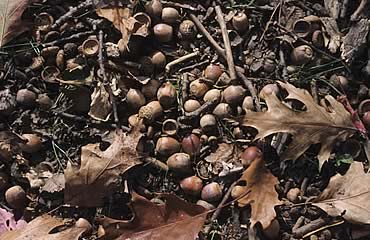The arrival of fall brings some welcome entrées for residents of the deer woods. That’s when acorns, beechnuts and other mast, hard and soft, mature and eventually drop to the ground, providing a nutritious change of diet for deer about to enter their energy-intensive rut.
The availability of acorns in particular changes both feeding and travel patterns of autumn’s whitetails. Even apples, corn and other fall favorites are secondary choices when acorns are at their peak. The wise hunter will search out acorn-littered woodlands in search of productive oak trees just prior to the season opener. Finding just the right tree in which to hang a stand is a standard preseason requirement.
Take a recent bowhunt in Missouri, when the grinding sounds emanating 15 feet below my treestand forced a muffled chuckle as I pictured my wife munching on her favorite snack – a hard, Pennsylvania-made, sourdough pretzel. Her annoying habit, however, was nothing compared to the munch-fest taking place beneath the bow stand set in an old white oak on the edge of a beanfield. That morning, on the walk back to camp, I came across the tree hanging heavy with acorns and decided to cart a climbing stand with me for the p.m. hunt.
Upon my arrival in mid-afternoon, all was stone quiet. But as dusk approached, I found myself surrounded by deer – noisy, hungry deer. It was a banner mast year, and the seven whitetails were taking advantage of a prolific acorn drop, chewing away to their heart’s – and stomach’s – content. The evening ended with an 8-pointer sprinting in and breaking up the gathering but not offering me a shot. However, three days later I received a call from my host who informed me that another bowhunter had taken the buck from “my” treestand, which had been left hanging in the old oak.
Red or White?
When it comes to acorn production, not all oaks are created equal. For one, mast from trees belonging to the white oak clan (white, post, chestnut, live and cow oaks, the latter also known as “swamp chestnuts”) are considerably sweeter and of more appeal to deer than acorns produced by the red oak family (red, black, scarlet, pin, burr and others). Secondly, white oak clan acorns take only a year to mature; red oaks require two years. Check the branches of any of the red oak tribe in late summer and you’ll discover first-year and the larger second-year acorns growing on the same branches. Little known is the fact that most of the 40 or so species of oaks in the U.S. must be at least 20 years old before they yield acorns. Trees twice that age often bear the best and most reliable crops.
When scouting, remember there’s no guarantee an individual oak that produced an abundance of acorns last year will also be prolific this year. In most woodlands, only a select few scattered oaks may produce good mast in a given year.
Poor Mast Can Mean Good Hunting
Paradoxically, some of the best hunting prospects occur when only a scattering of trees yield acorns. That’s when deer are more likely to revisit specific trees time and again rather than roaming the countryside as they do when acorns are abundant everywhere. In a banner year, when good mast is widely available, deer will have plenty of food and more of a tendency to wander. They’ll also abruptly abandon a site that may have had a substantial acorn drop but lost its attraction when every morsel was consumed and the deer moved on.

Acorn production can vary dramatically from one year to another. Take, for example, a Pennsylvania study some 20 years back that revealed a crop of 8 pounds per acre one year and 528 pounds on the same acre the following year. Oaks, it appears, can be quite fickle.
High Carb Diet
Acorns have high fat and starch content but are low in protein. That creates a more rapid and efficient digestion of the nut’s soft, inner nutrients and more acorns can be devoured during the fall bounty. As long as acorns are dropping or can be reached from the lower branches, deer will continue to feed on them, often ignoring other crops. Hunters who have the opportunity to observe deer on a regular basis know that during acorn binges, notable weight gains are evident on individual deer in a couple weeks or less.
Acorns that aren’t devoured in fall by deer, songbirds, squirrels, chipmunks, bears, turkeys and other wildlife will be sought in winter when some scratching and digging may be necessary to reveal them.
In October, everybody, it seems, loves a nut.
– Photos by Tom Fegely
This article was published in the October 2005 edition of Buckmasters Whitetail Magazine. Join today to have Buckmasters delivered to your home.